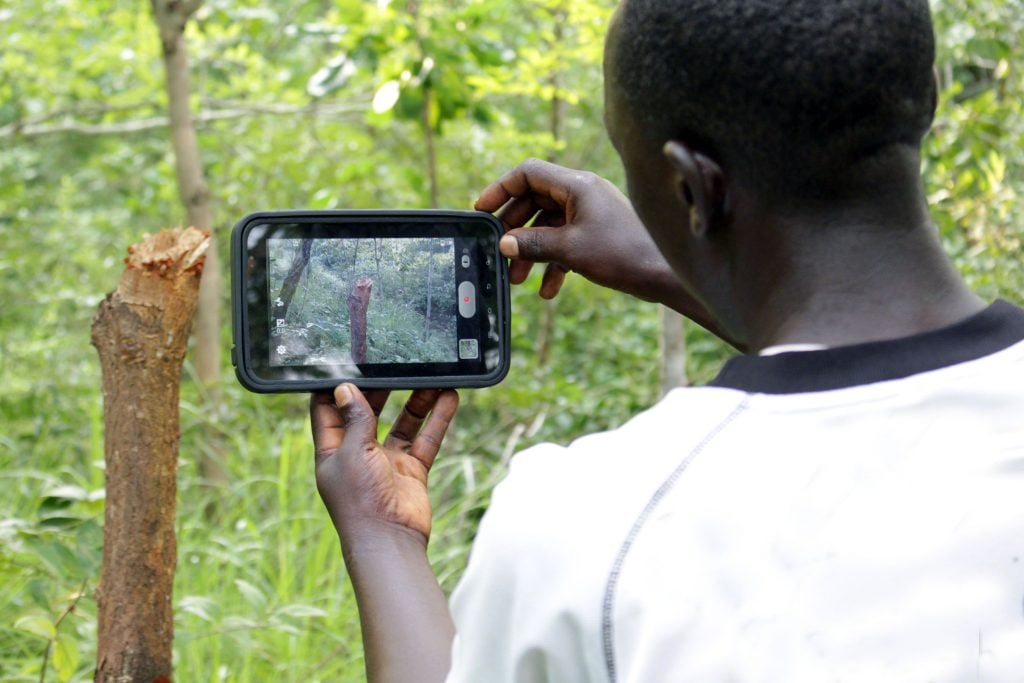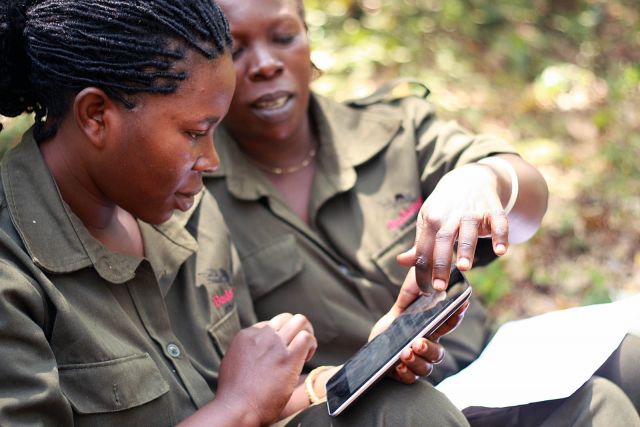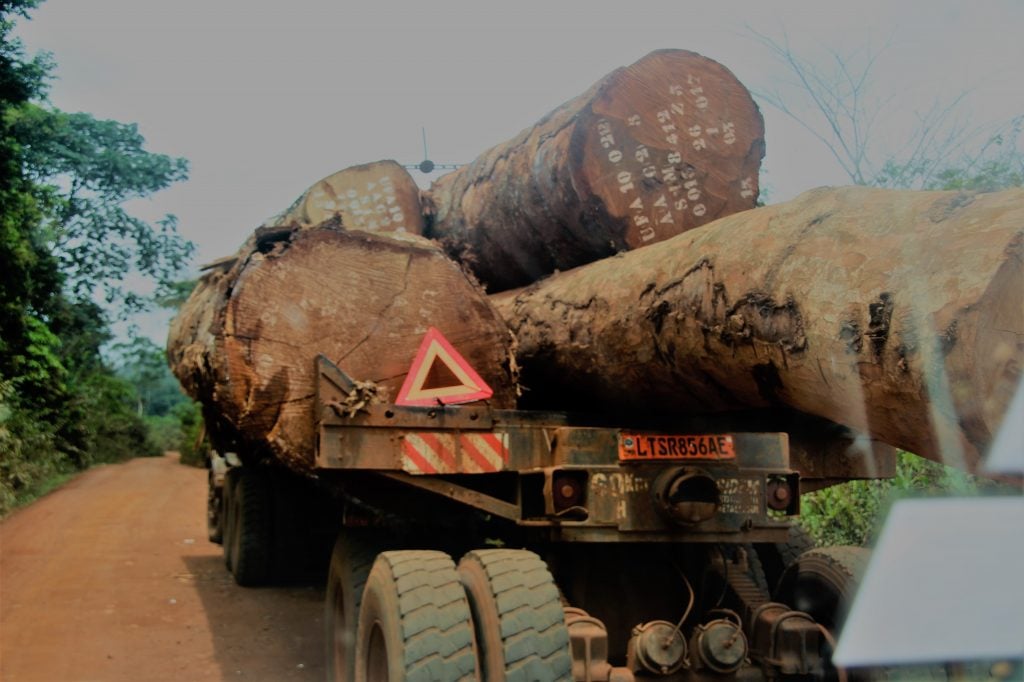Akame Clovis 43, a forest guard with the Ministry of Forestry and Wildlife marches through the Mefou National Park in Yaounde, an area with one of the highest concentration of primates rescued from the hands of illegal poachers in Cameroon.
Due to limited resources and capacity, Akame sticks to the same well-worn trajectory for his routine daily patrol around the park and nearby forest.
“I don’t have ample information on what is happening further in the forest, and this makes my work very challenging,” Akame says.

In the Congo Basin Forest region deforestation often occurs in remote areas far from view, making monitoring and protecting these places difficult even for those working on the ground. Photo credit/Jane Goodall Institute
While the park and its surrounding forest some 200 km from the capital city is better protected due to proximity, the dense rainforests further in the Centre, South and East regions rich in animal and tree species, is increasingly under threat amid global demand for mineral, energy and wood resources from Africa, experts say.
Like Akame many forest defenders in Cameroon say they often miss illegal deforestation and poaching activities that regularly encroach their forest areas for want of real-time information.
In the Congo Basin Forest region deforestation often occurs in remote areas far from view, making monitoring and protecting these places difficult even for those working on the ground. Poachers and logging companies systematically violate national laws to plunder the country’s forests according to the Center for Environment and Development, CED, an NGO protecting the rights of forest people in Cameroon.

“With Forest Watcher, we can now have intelligence-led patrols in the heart of the forest,” Manfred Epanda, Cameroon country coordinator for African Wildlife Foundation. Photo credit/World Resources Institute
The Cameroon Forest authorities say while National Parks are better protected, many forest areas are still vulnerable and persistently exploited illegally. Due to limited resources and capacity, the work of the forest guard authorities, law enforcement officials, and indigenous forest communities have become perilous with many field agents exposed to recurrent attacks from poachers and illegal wildlife and timber exploiters officials say.
“The government is aware of the challenges in the protection of forest resources, a situation made even more difficult by limited resources,” noted Philip Ngole Ngwese, Minister of forestry and wildlife at a ceremony to burn more than three tons of pangolin skins and scales seized from illegal poachers and smugglers in Yaounde recently.
Cameroon’s forests are the second largest in Africa, at more than 23 million hectares, and have a major role to play in the country’s economic development, the fight against climate change and global forest conservation targets, the government says.
But a report by Global Forest Watch shows an increase in forest loss in Cameroon between 2001-2014 generally ( 657 057 H) as opposed to forest gain between 2001-2012 of 65 088 Ha.
The loss experts say does not only accelerates the destruction of the ecosystem and diminishing resilience to climate change but also impacting on the economy of the country.
“The economic and environmental impact of forest loss is immeasurable, necessitating urgent measures to redress the problem,” says Dr. Paul Donfack, a consultant with the African Forest Forum, AFF.
But the launching of a new forest monitoring application, Forest Watcher, September 26th, 2017 brings hope that things may change for the better. The ministry of forestry and wildlife say with the new application users can receive forest change alerts, navigate to important areas and report on what they see, all from a mobile device. The innovation will significantly improve the fight against forest loss, the government assures.
Forest experts say deforestation and illegal wildlife activities take place beyond the view of those with the mandate or power to stop it. While systems like Global Forest Watch monitor forests remotely, those on the frontlines in the fight against deforestation and wildlife protection often lack internet connection needed to access and act on this information.
The new mobile app Forest Watcher changes this equation, giving those on the frontline, the forest guards, law enforcement agents and authorities and the indigenous forest communities the much-needed information to act accordingly.
“With Forest Watcher, we can now have intelligence-led patrols in the heart of the forest,” Manfred Epanda, Cameroon country coordinator for African Wildlife Foundation.
“Forest Guards will no longer go randomly to places, but instead know where to look for the latest forest loss and wildlife threats,” he says.
Forest Watcher is a free mobile application for forest monitoring and reporting in the field. The app accordingly allows users to access Global Forest Watch deforestation alert systems easily, monitor areas of interest, navigate to alerts and report information – regardless of internet connectivity.
Forest and Wildlife experts say Forest Watcher will change the workflow and response time for forest managers, civil society, forest dwellers and law enforcement on the frontlines of forest protection.
Also Read: The Road to Destruction
“It’s a tremendous application that will greatly assist our joint patrols, the Ministry and AWF so we can better apprehend some poachers in the future,” Manfred Epanda says.
The application accordingly is designed to allow easy, offline access to data about forest change from Global Forest Watch. It displays forest change straight on the mobile devices in the hands of forest guards, managers, indigenous communities and law enforcement anywhere in the world, regardless of connectivity.
“After first installing the app and caching data to your device, the app directs users to nearby forest clearing – even without a cell signal. It also enables users to capture photos and fill out forms about deforestation they do encounter, which they can upload when back within internet reach,” Albert Njongue of the Ministry of forestry and wildlife explains.
By connecting “eyes in the sky” with boots on the ground, deforestation can be located and reported more easily than ever before, he says.
Recent advances in satellite monitoring have enabled a significant leap in the understanding of the global deforestation. But people on the ground, forest guards, indigenous forest communities, forces of law and order remain best positioned to monitor forests and manage their resources.
The Forest Watcher Application comes in handy to better empower “The ground people” to be active participants in forest and wildlife protection and management.
According to Tarh Eric of The Last Great Organisation (LAGA), the new application will significantly help in tracking down the multiple cases of abuse in wildlife per Cameroonian wildlife law. The Cameroon wildlife law enforcement model he says is built around the collaboration between the Ministry of Forestry and Wildlife and LAGA.
Many rescued Chimps and other wildlife from ground operations are harbored in the Mefou National Park in Yaounde he says. The conservation efforts is that of government and the Cameroon Wildlife Aid Fund, CWAF that engages in rescuing endangered young primates from poachers, raising them in the park before eventual release into the wild. The Mefou National Park according to the Ministry of Forestry and Wildlife is home to more than 250 primates like gorillas, chimpanzees, and monkeys currently.

Truck transporting logs in Djoum. Forest communities are demanding clarity in the management of financial fallouts and the creation of an independent body that will ensure transparency and improve governance in a complex and troubled sector Photo credit/Eugene Ndi
According to information from the ministry of forestry and wildlife, an earlier version of Forest Watcher has been developed and used in Uganda since 2014 by the Jane Goodall Institute. JGI trained hundreds of private forest owners, forest authority offices and protected areas rangers how to use mobile tools to navigate to GFW deforestation data in the field and collect evidence to support conservation action – leading to prosecution and fines for offenders.
By linking remote sensing systems to local forest monitoring efforts, Forest Watcher brings the analytical power of the space age to the palm of every environmental defender’s hand.
Protecting forests is widely seen as one of the cheapest and most effective ways to reduce the emissions driving global warming. Loss and degradation of forests account for about 15 percent of emissions each year, conservation groups say.
“This forest monitoring innovation is a big step forward in forest protection and the drive to reduce carbon emissions in the Congo Basin forest region,” says Samuel Nguiffo of CED.
Forests in the Congo Basin cover about two million sq km – nearly the size of Mexico – but are shrinking by 5,600 sq km a year.
“The fight against forest loss requires countries to create national investment plans to address the pressures driving deforestation, illegal logging and endangered animals, such as gorillas,” Nguiffo said.
